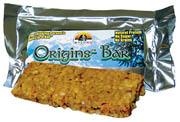
Blocks weighing 40 lbs. and bricks as small as 1 lb. are being run through chamber units, and even larger blocks are being packaged in modified units. By removing a seal bar, cheese makers are vacuum packing 260-lb. blocks of Swiss, parmesan and other cheeses, replacing snorkel-vacuum machines that evacuate only half the atmospheric oxygen with chamber units that leave as little as 0.5%, says Multivac's Bill Williams, product manager of chamber systems.
Automatic and semi-automatic bagging systems are opening the way for chamber applications for smaller products. "Getting product to the equipment more efficiently is a big focus," reports Bill Kuecker, marketing director-foodservice for Duncan, SC-based Cryovac. Tillamook Creamery switched from roll-stock to the cleaner look of vacuum pouches for 1-lb. cheese bricks. The switch, which eliminates roll-stock's untrimmed ears, would be prohibitively expensive without an automated loading system.
The premium on fresher-tasting food also is expanding vacuum applications in foodservice, Kuecker adds. Both refrigerated and frozen foods are making use of skin packs to preserve freshness and prevent off flavors. Fully cooked meat is being delivered to restaurants in a new film and tray that allows it to be cooked, shipped and reheated in the same package, reducing loss in yield and expediting preparation.
While Cryovac continues to innovate on the material side, the Japanese-built rotary chamber machines it distributes have changed little over the years. Commonly referred to as an octopus, they are space-intensive. Alcan recently debuted a more space-efficient chamber system. The first commercial installation was at a US meat processor in January. Declining to identify the processor, Mark Ewig, Alcan's marketing manager-meat protein, says the high-speed, servo-driven system will package up to 45 boneless hams weighing 2.5 lbs. per minute when outfitted with four chambers.
Another upgrade is a Kevlar drive belt for smoother operation and less maintenance due to metal-chain stretching, according to Ewig. Sensors detect if product is on a platen as it passes under a chamber; vacuum is engaged only when needed, reducing wear on pumps.
As Alcan and Cryovac go toe-to-toe with machines for big-volume processors, Multivac focuses on smaller manufacturers of further-processed meats. What they lack in speed and automation, Multivac's chamber units make up for in versatility and lower costs, says Williams. The units feature top-and-bottom sealing, an approach that reduces sealing time and the number of leakers. Another distinction is placement of vacuum nozzles in the lid, where they are protected during washdown. "The vacuum is the heart and soul and the most expensive part of the machine," Williams says. "There's no way water can get into these."
Multivac also fabricates vacuum roll-stock machines.
For more information:
Mark Ewig, Alcan Packaging,
773-399-3105,
mark.ewig@alcan.com
Bill Kuecker, Cryovac Food Packaging,
864-433-2000
Bill Williams, Multivac Inc.,
816-891-0555
Finally, a snack food that outshines its package.
Billed as "the thinking person's meal-in-a-bar," the $1.89 Origins Bar is based on the premise that substance trumps style. The validity of that theory will be tested as Midland, MI-based Wysong Corp. begins distribution to gyms, health food stores and natural foods supermarkets.
"The technology we're using was originally developed for electronics and then caught on in pharmaceutical," explains Vivek Savant, a Wysong research scientist who developed Origins' formulation. While Savant cannot discuss specifics of the nutrient-protective process, he says control of water activity is a critical component in the bars' six- to eight-month shelf life. Natural stabilizers and ingredients such as cashews help prevent off flavors and preserve proteins.
Wysong recently began manufacturing foods for humans. It is best known for pet foods produced in its Lake Mills, WI, facility, using technologies such as cold processing, extrusion and enrobing to protect vitamins, enzymes and other heat-sensitive nutrients.
For more information:
David Dauer, Wysong Corp.,
989-631-0009

